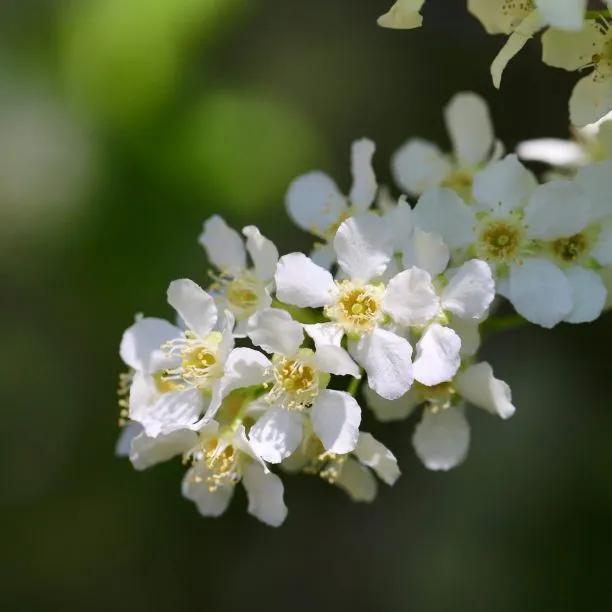Watereri Bird Cherry Large Trees

The details
- Native. Hardy, suitable for poor soils.
- Long cones of scented white flowers.
- Good for birds & bees.
- RHS Award of Garden Merit
- Max. Height: 18m
- Bareroot Delivery: Nov-Mar
Recommended extras
Description
Prunus padus Watereri: Bareroot Ornamental Bird Cherry Trees in Standard Sizes
Watereri is an ornamental variety of the native Bird Cherry tree, from which it only really differs in its size and the length of the flower cones. It is a little less bushy than its parent, and a bit taller and more vigorous.
The white flowers smell of almonds and have yellow centres; a beautiful sight in spring, when the tree is bursting with flower cones (called racemes) up to 20cms in length, and buzzing with bees and butterflies. In autumn, the flowers are followed by numerous small, safe but inedible, black fruit that contrast well with the bold yellow autumnal colours of the foliage.
Mature trees will spread a little, but it has an upright habit overall, so it's suitable for most gardens, and can reach a height of about 12-15 metres.
Browse our variety of cherry blossom trees or our full range of garden trees.
Delivery season: Cherry blossom trees are delivered bareroot during late autumn and winter, approximately November-March inclusive.
Choosing a size: Small trees are cheaper, easier to handle and more forgiving of less than ideal aftercare, so they are best for a big planting project. If instant impact is your priority, or if you are only buying a few plants for use in a place where it is convenient to water them well in their first year, then you may as well use bigger ones. All our bareroot trees are measured by their height in centimetres above the ground (the roots aren't measured).
Features:
- Height: To 15m
- Soil: Any decently well drained
- Use: Screening, urban, avenue
- Colour: White, fragrant flowers in April-May
- RHS Award of Garden Merit
- RHS Plants for Pollinators
- Bareroot delivery only: November-March
Growing Watereri Cherry Trees
This tough tree will grow in any soil with decent drainage, even compacted ones, and is highly resistant to pollution. It will flower significantly less in partial shade, so we recommend planting in full sun.
Did You Know?
This tree was bred in 1914 and was called Prunus padus Grandiflora at first. It has won both the RHS Award of Garden Merit for being both simple to look after and beautiful, as well as the Award of Merit for its cut flowers.
Standard trees are measured by their girth in centimetres 1 metre above ground level: their trunk's waist measurement. Unlike sapling trees and hedge plants, standards aren't measured by their height, which will vary quite a bit both between and within species.
So, a 6/8cm standard tree has a trunk with a circumference of 6-8cm and an 8/10 standard has a trunk 8-10cm around. This measurement makes no difference to the tree's final height.
On average, standard trees are 2-3.5 metres tall when they arrive, but we cannot tell you precisely how tall your trees will be before we deliver them.
Planting Instructions
Notes on planting Prunus padus Watereri trees:
Prunus padus Watereri is a very hardy plant that thrives on poor, dry soils. It needs close to full sun to look good and it may struggle on shallow chalk, although it is fine for most alkaline sites.
It will not grow well in the shade or on damp sites. It is not suitable for coastal areas and we don't recommend it as a windbreak tree for exposed areas because the wind will blast it out of shape.
Prepare your site before planting:
It is good to dig over the site where you plant a tree several months in advance. Kill the weeds first: for tough weeds like nettles, brambles and ground elder, you will usually need a weed-killer to get rid of them. When you dig the soil over, remove stones and other rubbish and mix in well rotted compost or manure down to the depth of about 2 spades.
Watch our video on how to plant a tree for full instructions.
Remember to water establishing trees during dry weather for at least a year after planting.
Tree Planting accessories:
Prepare your site for planting by killing the weeds and grass with Neudorff WeedFree Plus.
You can buy a tree planting pack with a wooden stake & rubber tie to support the tree and a mulch mat with pegs to protect the soil around the base of your tree from weeds and drying out.
We suggest that you use mycorrhizal "friendly fungi" on the roots of all newly planted large trees: if your soil quality is poor, we strongly recommend it.
You can also improve your soil with bonemeal organic fertiliser and Growmore.


